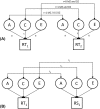Genetics of Perceived Family Interaction From 12 to 17 Years of Age
- PMID: 31127448
- PMCID: PMC6554250
- DOI: 10.1007/s10519-019-09960-z
Genetics of Perceived Family Interaction From 12 to 17 Years of Age
Erratum in
-
Correction to: Genetics of Perceived Family Interaction From 12 to 17 Years of Age.Behav Genet. 2019 Sep;49(5):484. doi: 10.1007/s10519-019-09963-w. Behav Genet. 2019. PMID: 31263991 Free PMC article.
Abstract
We analyzed how the effects of genetic and environmental factors on the perceptions of family interaction change from early to late adolescence. The data were collected by postal surveys on Finnish twins (N = 4808) at 12, 14 and 17 years of age and analyzed using genetic twin modeling. Additive genetic factors explained a modest share of the variation in perceived relational support (a2 = 0.30 in boys and 0.18 in girls) and relational tensions (a2 = 0.13 and 0.14, respectively) at 12 years of age, with the proportions becoming larger through 17 years of age (a2 = 0.53 in boys and 0.49 in girls for relational support; a2 = 0.35 in boys and 0.33 in girls for relational tensions). Simultaneously, the role of environment shared by co-twins decreased. These findings suggest that the associations between perceived family interaction and other factors in adulthood should be interpreted with caution, because they partly reflect genetic background, whereas in childhood, they may provide more reliable information on parental characteristics.
Keywords: Adolescents; Family interaction; Genetics; Twins.
Conflict of interest statement
Karri Silventoinen, Jinni Su, Lea Pulkkinen, Peter Barr, Richard J. Rose, Danielle M. Dick, Jaakko Kaprio declare that they have no conflict of interest.
Figures

Similar articles
-
FinnTwin12 Cohort: An Updated Review.Twin Res Hum Genet. 2019 Oct;22(5):302-311. doi: 10.1017/thg.2019.83. Epub 2019 Oct 23. Twin Res Hum Genet. 2019. PMID: 31640839 Free PMC article. Review.
-
Perceived Family Cohesion Moderates Environmental Influences on Prosocial Behavior in Nigerian Adolescent Twins.Twin Res Hum Genet. 2017 Jun;20(3):226-235. doi: 10.1017/thg.2017.15. Epub 2017 Mar 28. Twin Res Hum Genet. 2017. PMID: 28347396
-
Genetic and environmental effects on body mass index from infancy to the onset of adulthood: an individual-based pooled analysis of 45 twin cohorts participating in the COllaborative project of Development of Anthropometrical measures in Twins (CODATwins) study.Am J Clin Nutr. 2016 Aug;104(2):371-9. doi: 10.3945/ajcn.116.130252. Epub 2016 Jul 13. Am J Clin Nutr. 2016. PMID: 27413137 Free PMC article.
-
Individual differences in adolescent religiosity in Finland: familial effects are modified by sex and region of residence.Twin Res. 1999 Jun;2(2):108-14. doi: 10.1375/136905299320565979. Twin Res. 1999. PMID: 10480745
-
Genetic and environmental etiology of the relationship between childhood hyperactivity/inattention and conduct problems in a South Korean twin sample.Twin Res Hum Genet. 2015 Jun;18(3):290-7. doi: 10.1017/thg.2015.26. Epub 2015 Apr 30. Twin Res Hum Genet. 2015. PMID: 25926162 Review.
Cited by
-
FinnTwin12 Cohort: An Updated Review.Twin Res Hum Genet. 2019 Oct;22(5):302-311. doi: 10.1017/thg.2019.83. Epub 2019 Oct 23. Twin Res Hum Genet. 2019. PMID: 31640839 Free PMC article. Review.
References
Publication types
MeSH terms
Grants and funding
LinkOut - more resources
Full Text Sources

